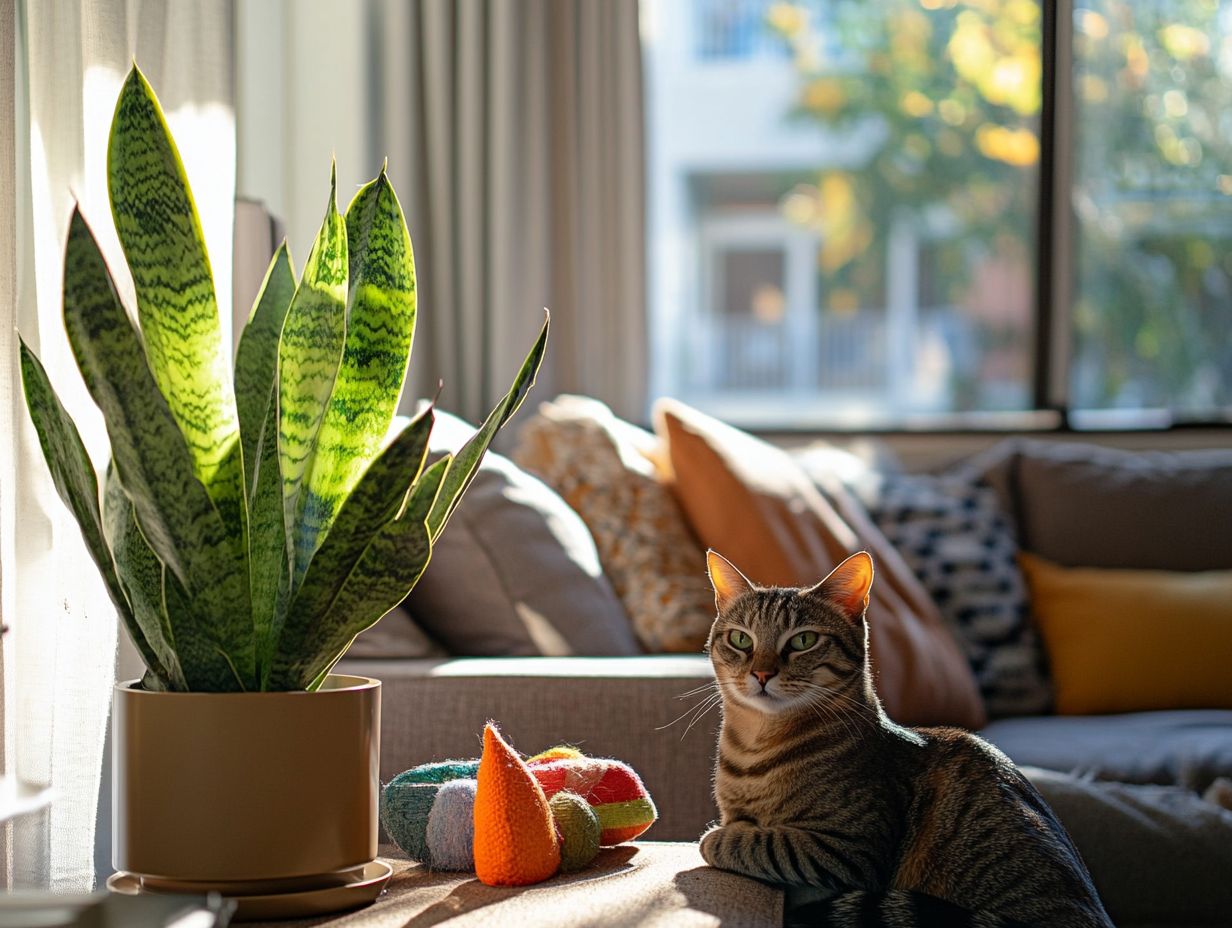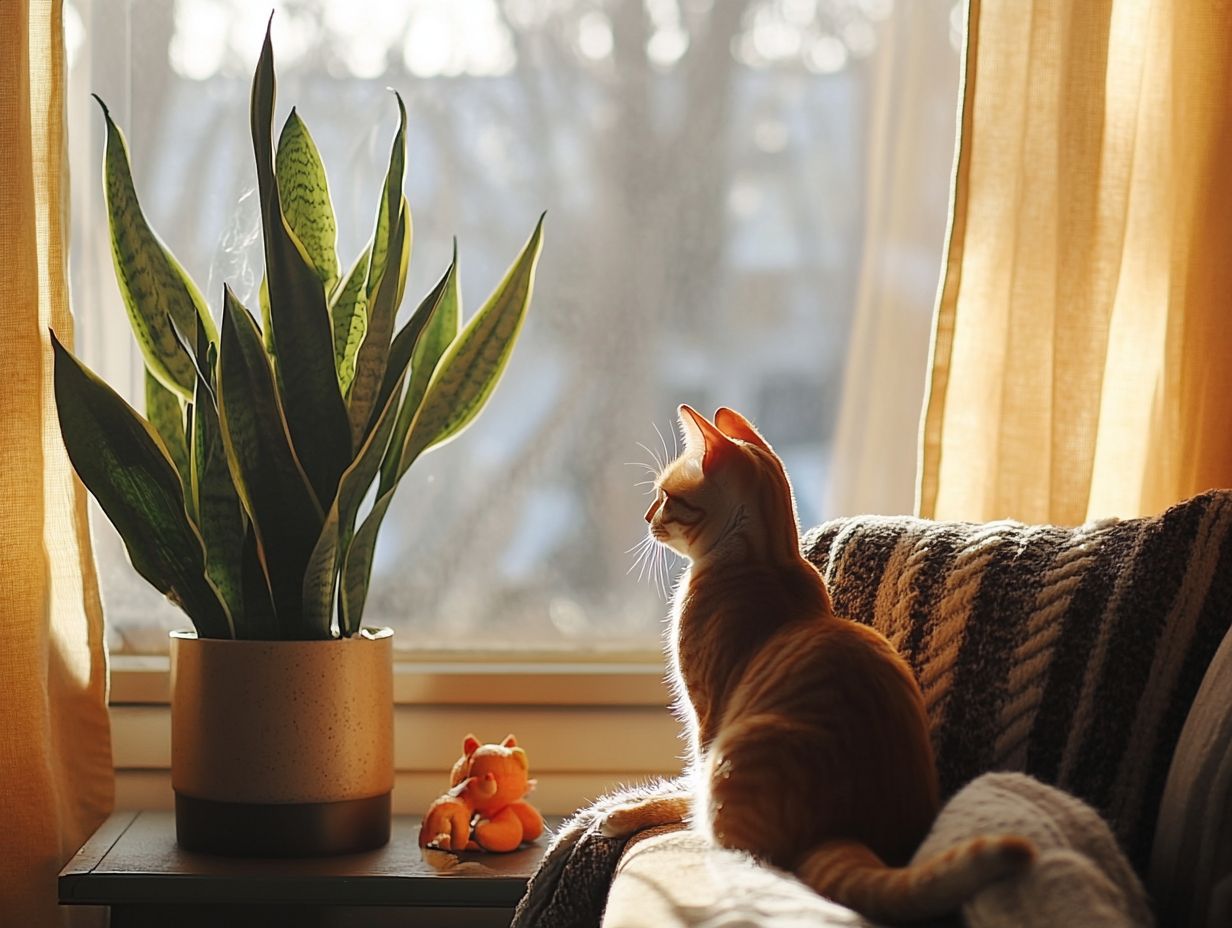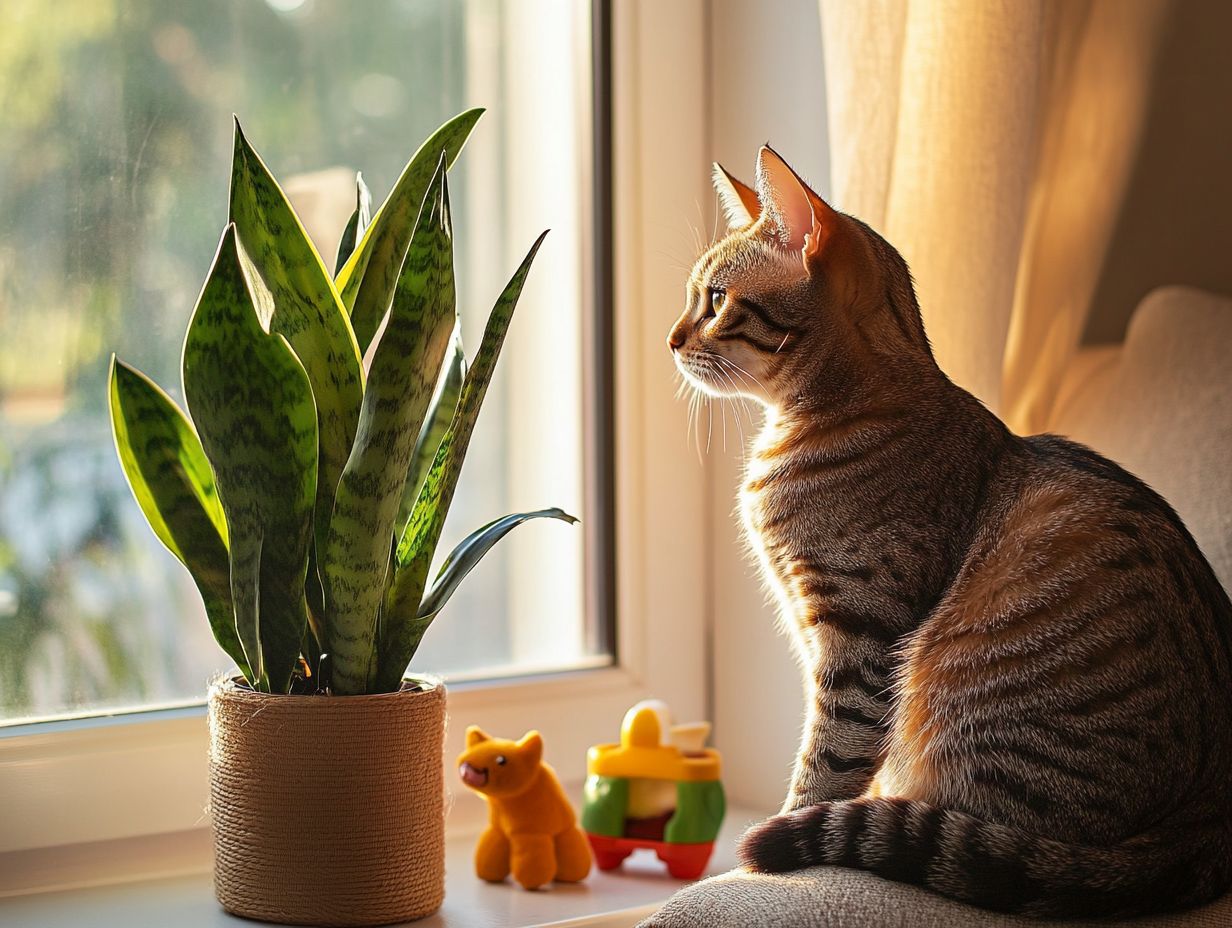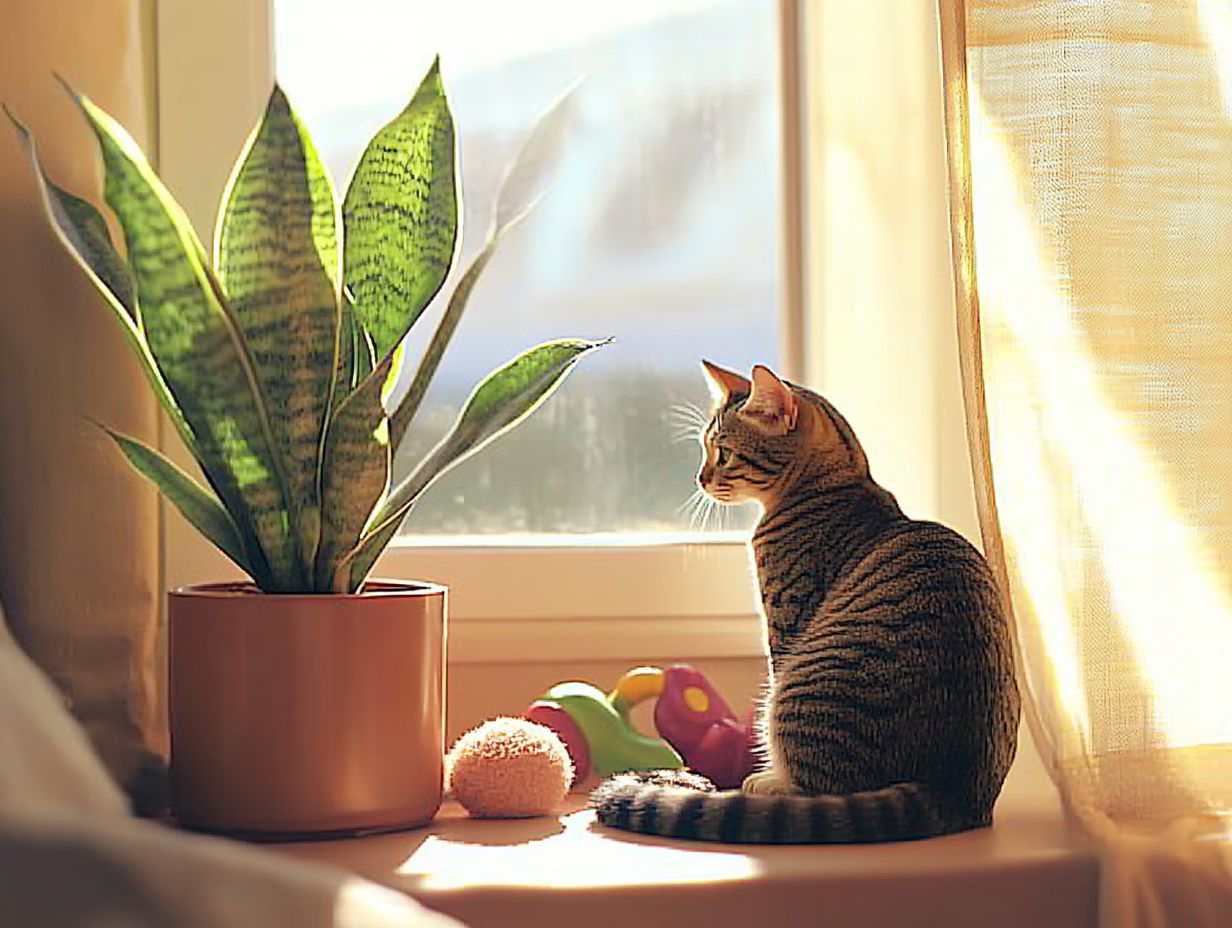Snake plants, known for their striking appearance and hardy nature, are popular houseplants among plant lovers.
If you’re a cat owner, you might be wondering about their safety. Are these lush greens harmful to your furry friend?
This article explores the toxicity of snake plants for cats, the symptoms of poisoning, and what steps you can take to keep your pet safe while enjoying the beauty of these unique plants.
Additionally, we suggest some pet-safe alternatives, such as Spider Plant, Areca Palm, and Parlor Palm, to consider for your indoor garden.
Key Takeaways:

What Are Snake Plants?
Snake plants, also known as Sansevieria trifasciata, are attractive houseplants renowned for their aesthetic appeal and air-purifying qualities. Native to West Africa, these plants are popular in indoor gardens because they thrive in low light and require minimal care, making them ideal for novice plant owners.
Additionally, they effectively filter harmful toxins from the air, including formaldehyde and benzene.
Are Snake Plants Poisonous to Cats?
Yes, snake plants (Sansevieria trifasciata) are toxic to cats, as stated by the ASPCA. These plants contain compounds that can lead to various health issues if ingested. The toxicity level is categorized as mildly toxic, primarily affecting the leaves.
What Are the Toxic Components in Snake Plants?
The primary toxic substances found in snake plants (Sansevieria trifasciata) are saponins, which are naturally occurring chemical compounds. When ingested by cats, saponins can cause nausea symptoms, vomiting symptoms, and diarrhea in cats.
These glycoside compounds serve as a natural defense mechanism for plants, imparting a bitter taste and toxic properties that deter herbivores from consuming them. Saponins disrupt cellular membranes, leading to gastrointestinal irritation in cats and other pets.
If a curious cat chews on snake plants, the resulting saponins can cause serious issues, such as lethargy and gastrointestinal problems, depending on the quantity consumed and the individual cat’s sensitivities.
What Are the Symptoms of Snake Plant Poisoning in Cats?
Symptoms of snake plant poisoning in cats can include:
- Mild Symptoms: Nausea, vomiting, diarrhea.
- Moderate Symptoms: Lethargy, loss of appetite.
- Severe Symptoms: Gastrointestinal upset, excessive drooling.
These signs may become apparent if a cat has ingested parts of the toxic Sansevieria trifasciata plant. It’s essential to recognize these symptoms of toxicity early.
Immediate veterinary care is essential to ensure the cat’s health and safety, as advised by the ASPCA and the American Veterinary Medical Association.
What Should I Do If My Cat Ingests Snake Plant?

If you suspect that your cat has ingested a snake plant, it is crucial to:
- Keep the cat calm and prevent further access to the plant.
- Collect any remaining plant material for identification.
- Contact your veterinarian or the Animal Poison Control Center immediately for guidance.
Snake plants can potentially cause gastrointestinal upset, so prompt treatment is essential for your cat’s health. Consult pet care resources like PangoVet for additional support.
Be prepared for possible treatments, which may include inducing vomiting or administering activated charcoal to minimize toxin absorption. Your veterinarian will likely perform a thorough examination and may monitor vital signs or conduct blood tests to assess the extent of snake plant ingestion.
How Can I Keep My Cat Safe Around Snake Plants?
Here are some effective ways to keep your cat safe around snake plants:
- Place snake plants in hanging planters out of reach.
- Use barriers to prevent access to the plants.
- Consider using deterrent sprays designed for pets.
- Regularly check that your plants are healthy and secure.
Common Misconceptions About Snake Plants
Many people believe that all houseplants are safe for pets. In reality, several common houseplants, including snake plants, can pose risks to pets. It’s crucial for pet owners to research plant toxicity before bringing new plants into their homes.
Special Considerations
Be aware that specific risks may apply to kittens, senior cats, or cats with pre-existing health conditions. Always consult your veterinarian if you have concerns about your pet’s health.
Always consult with your own veterinarian for personalized advice, as individual cases may vary.
For emergency situations, contact the ASPCA’s Animal Poison Control at (888) 426-4435.
This content will be reviewed and updated regularly based on new research findings, so check back for the latest information.
For more information, check our articles on common houseplants and their toxicity.
With informed and proactive measures, you can create a pet-safe indoor garden that features non-toxic and non-irritating alternatives to potentially harmful plants. Please note that snake plants are classified as toxic to cats, particularly due to the presence of saponins in their leaves, which can lead to health issues if ingested.
1. Place Snake Plants in Inaccessible Areas
To protect your cat from snake plants, a good strategy is to place these plants in areas that are out of reach, such as high shelves or in rooms where your cat is not allowed. This approach should complement the overall design of your indoor garden to ensure it remains pet-friendly.
A pet-safe indoor garden can incorporate barriers or decorative plant stands to elevate snake plants beyond your cat’s reach while aligning with your decor. Additionally, introducing non-toxic plants alongside snake plants can help divert your cat’s attention, making them less likely to investigate hazardous areas.
Consider using hanging planters or wall-mounted arrangements, which not only secure your plants but also enhance your decor, creating a comfortable space for both you and your cat.
Common misconceptions suggest that snake plants are completely safe for pets. However, it is crucial to recognize that these plants can be harmful due to the toxic compounds they contain. Always err on the side of caution.
2. Use Cat Deterrents
Cat deterrents are effective methods for keeping cats away from snake plants, ensuring the safety of both the plants and the cats. There are various strategies to consider for deterring cats.
- Citrus sprays can be used, as cats generally dislike strong odors.
- Textured mats can be employed to prevent cats from walking near the plants.
- Training techniques, such as clicker training, can help reward positive behaviors that steer cats away from the plants.
For those who prefer to have plants indoors, choosing safer alternatives like spider plants or pothos can be beneficial, as these options are less toxic while still providing visual interest.
In the case of snake plant toxicity, potential symptoms in cats can be categorized as follows:
- Mild: Vomiting, diarrhea, and mild lethargy.
- Moderate: Increased drooling, loss of appetite, and abdominal pain.
- Severe: Severe lethargy, tremors, or depression. Immediate veterinary care is advised for severe cases.
3. Train Your Cat to Stay Away from Plants
Training your cat to avoid snake plants is an excellent way to ensure their safety and well-being in a household where these toxic houseplants are present. Positive reinforcement training methods can be particularly effective in this regard.
By rewarding desirable behavior with treats or affection, pet owners can teach their cats to steer clear of dangerous plants. Consistency in training is crucial, as regular sessions reinforce boundaries over time. Training helps with dietary concerns and ensures care for cats.
Additionally, providing cat-friendly plants such as catnip or spider plants offers safe alternatives, creating a more enriching environment. This not only distracts from poisonous choices but also fosters a positive association with safe options.
What Are Some Pet-Safe Alternatives to Snake Plants?

Safe alternatives to snake plants for pet owners include the Spider Plant, Areca Palm, Boston Fern, Parlor Palm, and Bamboo Palm. These plants are safe for cats and can enhance the aesthetics of your indoor garden.
1. Spider Plants
Spider plants are an excellent choice for pet owners, as they are safe for cats and also serve as air-purifying, low-maintenance houseplants. These hardy plants thrive in various light conditions, making them suitable for all indoor settings.
They can flourish in a bright corner of the kitchen or a low-light living room, requiring minimal care. The gracefully arching leaves, adorned with striking green stripes, enhance the visual appeal and create a relaxed atmosphere in any space.
Additionally, spider plants produce charming baby plants, or “pups,” making them a delightful addition to your plant collection. Their resilience and pet-friendly nature further solidify their status as a perfect choice for any home.
2. Boston Ferns
Boston ferns are popular indoor plants that enhance vibrant indoor gardens and are safe for cats. Renowned for their air quality benefits and beautiful foliage, Boston ferns thrive in humid conditions and indirect sunlight, making bathrooms or kitchens with natural light ideal locations for them.
First Aid for Snake Plant Ingestion
If you suspect your cat has ingested snake plants, follow these steps:
- Remove any remaining plant material from your cat’s mouth.
- Observe your cat for any symptoms of toxicity.
- Contact your veterinarian immediately for advice.
- Provide the veterinarian with information about the plant and the amount ingested.
Expert Insights
Veterinarians and animal toxicologists emphasize the importance of being aware of the plants in your home and their potential risks to pets. Always consult your vet for specific concerns regarding plant safety.
Conclusion
For the safety and well-being of your pets, it’s essential to choose non-toxic plants and take precautions with those that are harmful. For emergencies, contact your local animal poison control or veterinarian.
Call to Action: Remember to regularly review the plants in your home and keep updated on pet safety. For detailed plant safety information, check resources like the ASPCA’s toxic plant database.
Disclaimer: This content is not a substitute for professional veterinary advice. Consult with your veterinarian for specific concerns.
Last updated: October 2023.
With regular misting and a consistent watering schedule, these ferns flourish beautifully. They not only add a welcome aesthetic that complements various decor styles but also serve as natural air purifiers, removing common air pollutants like formaldehyde and benzene. If you have pets, you might wonder Should I Keep Snake Plants Away from My Cat? A Pet-Safe Guide to ensure their safety.
Pet owners appreciate the beauty of Boston ferns, especially the absence of poisonous risks associated with incorporating this plant into their indoor environment.
3. African Violets
African violets are safe for cats and are beautiful flowering indoor plants available in a variety of colors and patterns. These houseplants thrive in moderate temperatures and prefer bright, indirect sunlight. African violets enjoy well-draining potting soil, as well as consistent humidity and temperatures, which are essential for healthy foliage and abundant blooms.
Versatile indoor plants, they can add color and warmth to any room, flourishing on windowsills or in shadier areas. They require minimal watering, preferring to be slightly dry rather than overly wet between waterings, making them ideal indoor plants for homes with pets.
If you have pets, you might wonder if cat grass could be a suitable distraction for them. Consider safe plant alternatives to ensure their safety.
Frequently Asked Questions about Snake Plants and Pet Safety
Toxicity Level: Toxic
Can Snake Plants be Harmful to Cats and Dogs?

Yes, snake plants (Sansevieria trifasciata) can be toxic to cats if ingested. They contain chemicals called saponins, which can cause gastrointestinal upset, nausea symptoms, and even vomiting symptoms if consumed. Source
Identifying Toxic Parts
The toxic parts of the snake plant include the leaves and stems.
What are the Symptoms of Snake Plant Toxicity in Cats?
Symptoms of snake plant toxicity can be categorized as follows:
- Mild Symptoms: Drooling, loss of appetite
- Moderate Symptoms: Vomiting, diarrhea
- Severe Symptoms: Tremors, difficulty breathing
The most common symptoms of snake plant toxicity in cats include drooling, vomiting symptoms, diarrhea in cats, and lack of appetite. In severe cases, it can also cause tremors and difficulty breathing, leading to serious health issues.
How Can I Tell if My Cat Has Eaten a Snake Plant?
If you notice your cat exhibiting any of the symptoms mentioned above, it is possible that they have ingested some part of a snake plant. You may also find evidence of plant material in their vomit or stool. It’s vital to contact an animal poison control center like the ASPCA for immediate advice.
First Aid Instructions for Snake Plant Ingestion
- Remove any remaining plant material from the cat’s mouth.
- Do not induce vomiting unless directed by a veterinarian.
- Contact your veterinarian or the ASPCA Animal Poison Control for guidance.
Are There Any Safe Alternatives to Snake Plants for My Home?
Yes, there are many pet-safe plants that you can choose from to decorate your home, creating a beautiful indoor garden. Some good options include spider plants, Boston ferns, and African violets. Additionally, consider other cat-friendly plants such as Areca Palm, Parlor Palm, and Bamboo Palm.
What Precautions Can I Take to Keep My Cat Safe from Snake Plants?
The best way to keep your cat safe from snake plants is to practice plant safety by keeping them out of reach. Here are some practical safety measures:
- Place the plants in areas that your cat cannot access, such as on high shelves or hanging from the ceiling.
- Use plant deterrents to discourage cats from approaching.
- Create a designated pet-safe area in your home.
Addressing Common Misconceptions
Some believe that snake plants are completely safe for pets. However, it’s important to clarify that they do pose risks if ingested.
What Should I Do if My Cat Has Ingested a Snake Plant?
If you suspect that your cat has eaten a snake plant, it is important to contact your veterinarian or the American Veterinary Medical Association immediately. They will be able to advise you on the best course of action based on your cat’s symptoms. Consulting resources like PangoVet and other pet care resources is also recommended.
Emergency Contact Information
For immediate assistance, contact the ASPCA Animal Poison Control at (888) 426-4435.
Disclaimer: The information provided is not a substitute for professional veterinary advice.
Last reviewed: October 2023